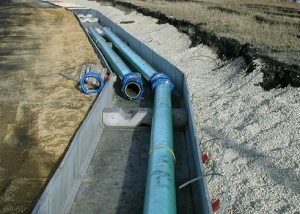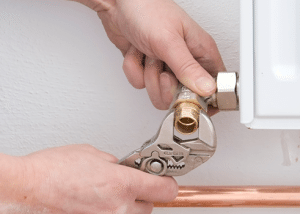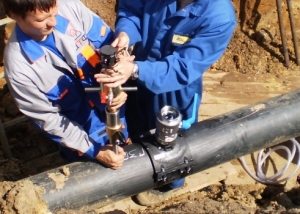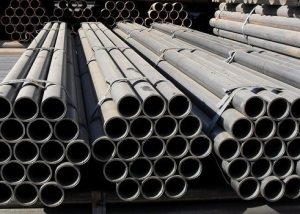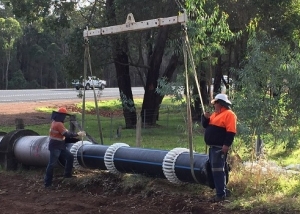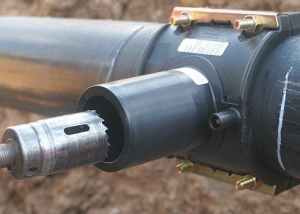Pipe area is a concept used in the calculations of three different product parameters - the outer surface, inner surface and section. When performing calculations related to the cross-section, in some cases it is necessary to deal with the so-called live cross-section. After calculating the area, it is possible to determine the amount of required materials and the level of costs required for the laying and full functioning of the pipeline.

The calculation of such an indicator as the area of the pipe may be needed during the construction of the pipeline, as well as its insulation, painting and other activities
Content
What are the parameters of the operation of pipelines associated with the calculation of the area of the pipe
At the design stage of the pipeline system, competent calculation of the pipe area allows you to achieve important advantages associated with different aspects of the laying, operation and further maintenance. In particular, how the pipe area was calculated will be associated with:
- patency of the pipeline system. It will be necessary to calculate, based on the values of the outer diameters and wall thicknesses, the area of the inner cross section of the pipe. This will make it possible to clarify the flow rate of the transported working environment, as well as the cost of the structure as a whole;
- heat losses occurring during transportation from a generating source (heat point) to heating appliances. To calculate the heat loss, it is necessary to operate with the values of the diameter and length of the pipes. Having an idea of the surface area of heat transfer and knowing how much heat is generated by the heat point, the number and dimensions of the heating devices in the system are calculated;
- thermodynamic parameters of the system, whether it is underfloor heating, the register of the heating system or a section of the pipeline;
- the amount of materials for thermal insulation, calculated, starting from the area of the outer surface;
- the amount of materials for applying an anti-corrosion coating;
- roughness of the inner surface, affecting the speed of movement of the working medium. The latter, in turn, depends on the values of the geometric parameters of the pipe.

Knowing the area of pipes, it is easy to determine the amount of materials for insulation of the system
How to calculate pipe surface area
To carry out the calculations, a formula that is memorable for the school textbook and the capabilities of the calculator, both regular and online, can be involved.
To determine the area of the outer surface of a round pipe, you will need the formula used in the calculations performed with the cylinder: S = π d l. In order to determine, for example, the required number of paintwork or heat-insulating materials, you need to know the values of such parameters as:
- l - the length of the product that will be subjected to appropriate processing;
- d is the outer diameter;
- S is the area that will be determined as a result of the calculations.
The value of π is taken as approximately equal to 3.14.
Note! Working with paints and varnishes, we focus on the estimated consumption per square meter indicated by the manufacturer.
Thermal insulation will require additional calculations and costs, since you should consider:
- the thickness of the insulating layer;
- the presence of overlaps of paintings, mandatory when laying mineral wool.
When making calculations on the inner surface, especially hydrodynamic ones, one should not forget about some important points:
- with an increase in the diameter and length of the pipeline, the hydraulic resistance of the working medium can be neglected due to a decrease in hydraulic friction against the walls;
- the value of the hydraulic resistance is more dependent on the roughness coefficient than on the surface size;
- the use of non-galvanized steel as a material for the pipeline over time leads to a decrease in the internal cross section and an increase in hydraulic resistance, since rust and mineral deposits are stratified inside.
The inner surface of a round pipe is calculated according to the formula: S = π (d - 2n) l, in terms of:
- π - approximately 3.14;
- d is the outer diameter;
- n is the wall thickness;
- l is the length of the plot.
How to calculate the cross section of the pipe
There is a certain nuance associated with the type of pipeline used - pressure or pressureless. In the case of a pressure pipeline, the calculation is much simpler and you need to use the formula S = π r2. That is, to calculate the cross-sectional area (S) of the pressure pipeline in which the transported medium occupies the entire internal volume, the following quantities are used: π - approximately 3.14; r is a radius equal to half the inner diameter or half the outer diameter minus the double wall thickness.
More complicated is the situation with similar calculations if you have to deal with gravity sewage or water supply. In such systems, unlike pressure systems, for almost the entire period of operation, the flow of the working medium affects only part of the walls, and not the entire internal volume. Thus, the value of hydraulic resistance is significantly lower.
On a note! When carrying out hydraulic calculations, it is customary to operate with the concept of a living section. By it is meant the part of the cross section that relates directly to the flow of the working medium, which is perpendicular to it.
What to do when dealing with a square tube in cross section? To calculate the area of a pipe of square or rectangular cross-section, you can resort to an online calculator or use the formula S = Pl. In addition to the values of area (S) and length (l), it also uses the value of the perimeter of the perpendicular section (P).
Despite the simplicity of calculating the area of the pipe, it is hardly worth it to be negligent in performing this operation. Errors can result in both an overspending of materials and money, and disruptions in the operation of the pipeline system itself.

